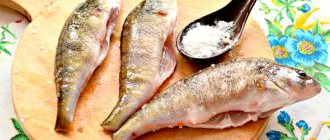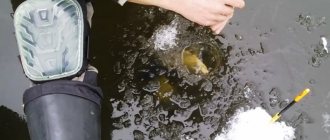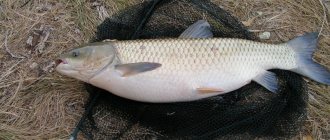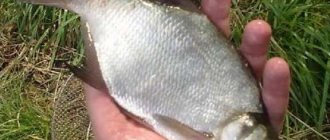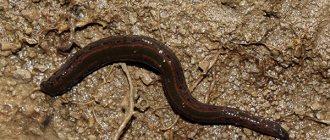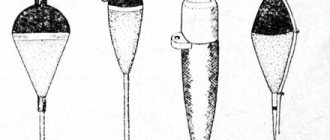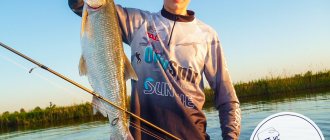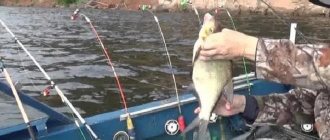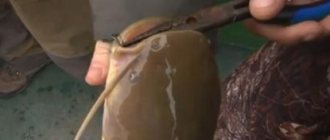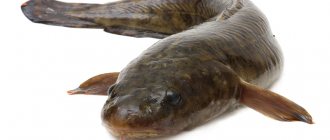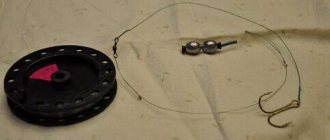Perch is a predatory fish. Perch is distributed almost throughout the entire territory of Russia. There are no perch in the Amur and its tributaries. You will also not find perch in mountain rivers, as well as in rivers and streams with cold water.
Perch is very different from other fish. The perch has a wide body with a hump. The back of the perch is brownish-brown, the sides are greenish-yellow, and the belly is yellowish. Transverse dark stripes are visible on the body of the perch. The caudal and pelvic fins of the perch are bright orange, the pectoral fins are yellowish. All fins of the perch, except the tail, have sharp, piercing needles. The gill covers have one sharp spine. Like many fish, the color of a perch depends on its habitat.
Look in the “fishing” section on this site:
perch fishing
Perch fishing. Perch is a diurnal fish and is caught from morning until dusk. In summer, perch is caught with a float rod or spinning rod, in winter - with spinners and jigs.
Perch is a wanderer, and this peculiarity in its behavior has been noticed: early in the morning, during feeding, it walks in schools not far from the shore to a certain place, and then returns back along the same road. In winter, anglers find these trails easily and line them up in long rows.
Perch is almost not afraid of noise, it is careless, greedy, and therefore becomes a frequent prey for anglers.
What to catch perch with
In summer, the type of bait remained the same, but the size had to be changed downward. Large “butter” vibrator tails were silent on the perch; the 3-inch Chunk Tail twister brought bites, but not as regularly as we would like. As a result, I began to experiment a lot with baits, and it turned out that changing them worked. I didn’t have to move much, and at one point the bite occurred when I threw something new. Basically these were the same vibrotails and twisters. The biggest bass were caught on a 3-inch Spark Tail and a 2-inch JIB Tail from Lucky John.
Particularly useful was the frequent change of bait when the perch came out. Although he pecked actively, he preferred something new every time.
In terms of colors, in recent seasons, variations in motor oil and greenish colors have usually worked. One zakiloshnik coveted the bloody color of the twister. In general, I am a supporter of using more twisters than vibrotails for catching perch - for some reason I have such preferences. But, at any time of the year, they are still not small. 2-4 inches is the most suitable size.
perch fishing in summer
Perch fishing in summer . In July - August in the summer, perch is caught in the upper layers of water, where it chases small fish. His favorite thing to do is catch perch in the summer using spinning rods. Small rotating spoons and twisters (preferably white or yellow) are used as bait for catching perch.
The most successful equipment option for catching perch is the “spaced” one. A 12-16 gram Cheburashka sinker is tied to the end of the main line, a hook No. 8 - 12 according to the European classification is tied to a separate leash 60 centimeters long, and a twister or vibrotail is attached to it.
This type of perch fishing in the summer can be done both from a boat and from the shore; it is only important to notice where the predator is fattening.
Places of mass hunting of perch for fry in summer (the so-called perch boilers) are determined by the concentration of seagulls. A flock of perch drives young fish to the surface and begins to eat them, and seagulls also take part in the feast. An angler notices a perch cauldron by a cluster of seagulls, swims up by boat or approaches on foot, takes out a spinning rod and casts the bait. Bites follow on every cast. The type of bait does not matter. Perch is caught with the most incompetent spoons, from which at other times all the fish scatter.
When catching perch in such an area in the summer with a small spinning spoon or twister, you can catch dozens of fish without leaving the spot. After some time, the perch boiler disappears, and perch fishing stops. Then a new perch pot appears in another place, and the angler rushes to it. This type of perch fishing is best in the summer on the reservoir and lake.
Where to look for a predator?
In winter, look for perch at a depth of 2-4 m in places with an uneven bottom surface, as well as with the presence of snags and reeds. The search for food occurs directly at the bottom. From February to March, the fish rise closer to the surface.
To achieve a large catch, it is necessary to probe not only a large water area, but also the depths of the reservoir. Perch prefers to hunt for food by gathering in schools. If a frenzied perch bite is detected in a reservoir in one place, and after a while it stops biting, then you should change the place of fishing. Fishermen often travel up to 10 km in 1 day, looking for places with a good bite.
Small rivers and lakes
There are places where fish are found in large quantities. These are channels with a quiet current, located between the shore and island ledges, as well as deep-water places located under the branches of bushes that are frozen into the edge of the ice. In such places, during warming, you can find ide and roach.
Not far from such places, there is a fast water flow along the edge. On small rivers and lakes, this fish looks for prey in places with large accumulations of algae. In these places, it can be lured closer to the surface of the water using spinners, poppers and surface wobblers.
On grassy lakes, perch can be found along the entire water area of the reservoir, but in an unfamiliar reservoir you need to look in places where there are steep slopes.
Large bodies of water
In large rivers and lakes, finding perch becomes more difficult. It can live in various places throughout the aquatic area. It is most rarely found in river beds at a depth of more than 4 m. In these places, only the humpback whale can be found. Most often, the flow in such rivers is slow.
You can find perch on the river at depths from 2 to 4 m. You can try to track the location of the school, guided by splashes of water.
Experienced fishermen look for perch in places where asp are found. These fish are most often found nearby, only perch prefers deep-sea places with calm currents. It is not easy to catch an asp, because... It is characterized by cautious behavior, but by its location it is easy to determine the presence of a school of perch in the immediate vicinity.
In river bays, this fish is found in places overgrown with reeds, water lilies, and near the edges. It is best to search at a depth of 2 to 3 m. It can live in sandy shallow water (mainly in the warm season).
This fish is found in large lakes and reservoirs close to the coastline:
- sandy;
- clay;
- peat;
- granite quarries.
In such reservoirs, the bottom depth can reach 20 m or more, so you should “hunt” for this fish along the coastal edge with vegetation.
perch fishing in autumn
Catching perch in the fall . In the fall and until the freeze-up, perch is caught with fry using a float rod. The rod needs no more than 6 meters. The main line is 0.2 - 0.25, the leash is 0.18 - 0.2 millimeters. Float with a carrying capacity of 8 - 14 grams. The shape of the float for catching perch in the fall for fry is better than a barrel - the fry does not drown it as much, and it is more resistant to the wind.
The fry are caught with a small fish, or simply with gauze or tulle. The fry must be alive; perch cannot be caught on a sleeping fry in the fall. The fry is placed in the current by both lips; in still water, carefully, so as not to damage the vertebrae, the hook is threaded under the back.
Basic recommendations
Fishing for large predators is very different from fishing for small river creatures. In order not to leave with nothing, the fisherman must not only have certain knowledge, but also have good dexterity.
To prevent the river robber from getting off the hook, you need to remember the following nuances:
- The perch attacks the bait very quickly and furiously. That is why you need to hook fish with great speed and force. Experienced fishermen advise rewinding the fishing line no more than 30 m, otherwise the predator may break loose and swim away due to sudden movements.
- The placement of the bait is selected taking into account the depth at which the fishing is carried out. As practice shows, perches are more attracted to sudden movements of bait.
- Considering the behavior of fish, it is recommended to use bright, visible baits.
The process of fishing for this predator is very interesting and exciting. But you need to remember that perch is a rather smart and cunning fish, so you need to approach the selection of gear and bait with maximum responsibility.
If the fisherman takes into account all the recommendations, chooses the right place and equipment, and also calculates the optimal time for fishing, luck will definitely smile on him and he will be able to boast of catching a large perch.
perch fishing in winter
In winter, perch fishing begins with drilling test holes from the shore and deep into the reservoir. The distance between them ranges from two to thirty meters. In the most catchable places, several holes are drilled.
The first ice provides excellent perch fishing in winter. This fishing lasts about 4-6 weeks, then gradually worsens and resumes only when melt water begins to flow under the ice.
In the middle of winter, good perch fishing occurs during long thaws or when the weather is more or less the same for several days. Perch can be caught throughout the day, but the peak perch bite occurs in the early morning and evening.
In winter, perch is caught using a jig, spoon or small balancer. Bloodworms, burdock moth larva, and fry are used as bait for catching perch. Sometimes success in catching perch in winter comes from a “sandwich” of bloodworms and burdock moth larvae.
In winter, if the perch bites have stopped, you should not immediately change the place of fishing. It is better to make several identical transactions with a higher rise in the same hole. If there is no bite from the perch, then at some distance from the first one, several more holes are drilled from different sides and renewed. If there are no perch bites even after this, they change fishing.
Recently, the method of catching perch in winter using a jig without a nozzle has become widespread. Cambrics or small beads of different colors are put on the hook of the jig. The most successful combination of yellow with orange, black and white.
There are certain requirements for winter tackle with a jig for catching perch. Everything in it should be well adjusted.
The nature and pace of retrieving the jig depends on the fishing season. At the beginning of winter, perch is quite active, so the game and lifting of the jig must be very fast. Another thing is catching perch in the middle of winter. Due to lack of oxygen in winter, perch becomes sluggish and motionless. At such times, the game and rise should be slowed down, sometimes it is enough to just move the jig at the bottom. At the end of winter, the perch becomes active again, and playing with a jig should be resumed again, but the rise should be done slowly. As a rule, the perch bite occurs at the moment the jig comes off or stops.
If the bite is weak, then the perch can be lured using a spoon. The perch is curious and is attracted to the spoon from afar, but it is cautious and does not bite. Then they throw the jig, and a bite follows.
Some craftsmen make a “TV” in winter to attract perch or pike perch. Live fry are placed in an 800-gram jar, and a lid is put on the jar. A wire is passed through a hole in the lid, which is connected to an LED or small light bulb. Plasticine is used to seal the joint. The power source is a size A coin cell battery.
Choosing the optimal location
If small specimens of fish are found throughout the reservoir, then larger groupers are usually located in special pits and only sometimes leave them in order to hunt for fry. You can also find predatory fish in snags and tall grass thickets.
That is why catching large perch is not a problem, but you will have to “sweat” in finding a suitable place. It also all depends on the conditions of the reservoir, to what size the perch can grow in it.
Fishing must be done correctly, in a suitable place, and you will also need to choose the bait wisely.
Regarding the location, I usually go to catch large perch on a spinning rod in Sazanya Bay. This is a fairly promising place; it’s not difficult to find fishing spots here. Moreover, here the fish really grow to impressive sizes, since there is enough food. You may not be able to immediately find specimens weighing 1.5 kg and pull them out, but nevertheless, the shells will be weighty.
As soon as you arrive at the pond, try to cast further away. In this case, success is guaranteed. Sometimes there are perches near the shore, but these are most often places for small fish, large ones are further away, they especially like to be in holes.
- Important! It is best to make casts in a checkerboard pattern, this way you will quickly find a place to catch perch.
I try to make casts at a distance of 0.5 meters from each other and gradually throw the bait.

